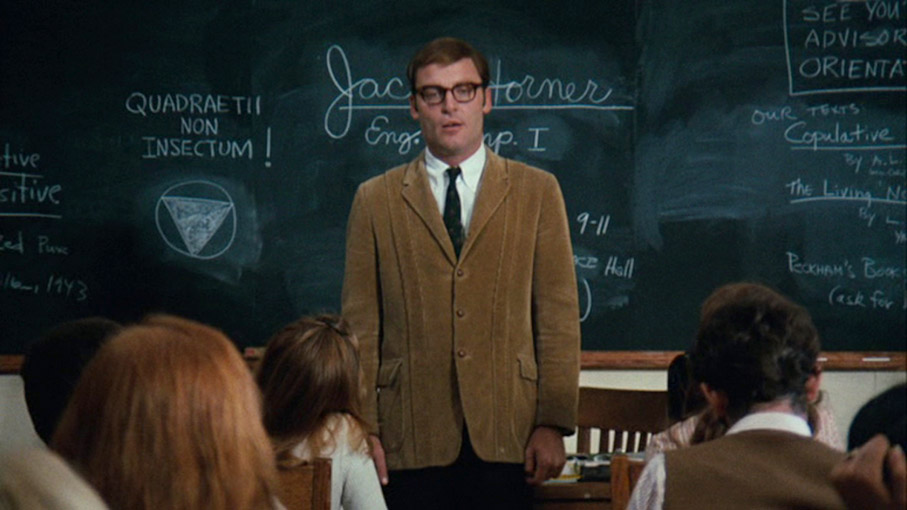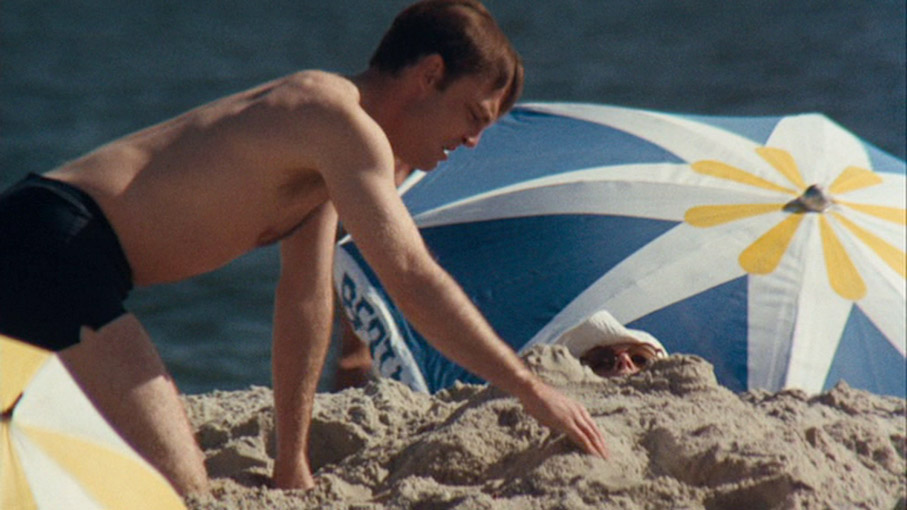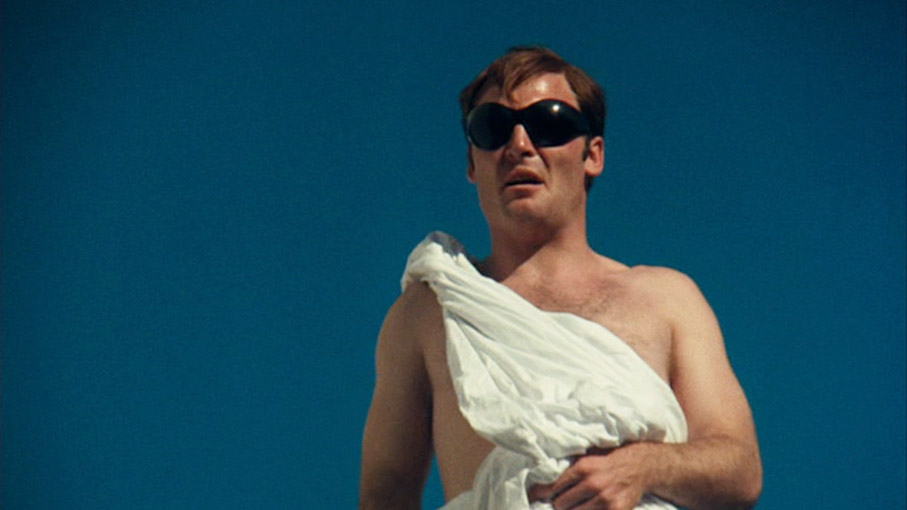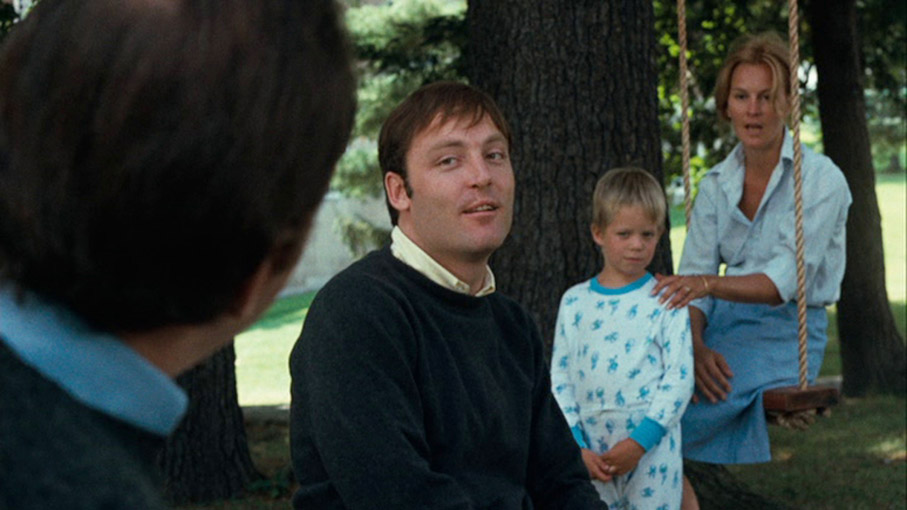|
John Barth died on 2 April 2024 at the age of ninety-three. He was a major American post-War writer, particularly for his novels The Sot-Weed Factor (1960) and Giles Goat-Boy (1966), both widely read, influential and attracting cult followings. End of the Road, released in 1970, remains the only screen version of any of his work and is a film of considerable merit, though one which for various reasons tends to fly under the radar nowadays.
We begin with Jacob Horner (Stacy Keach), who walks out of his graduation ceremony. Overwhelmed by the horrors of the time and an inability to choose between the many options open to him, he has a catatonic episode on a nearby railway station platform, while the film fragments into a montage of images of war, countercultural protest and atrocities while Billie Holliday's "Don't Worry 'Bout Me" plays on the soundtrack. He is found by Doctor D (James Earl Jones) who takes him away to "The Farm", a bizarre mental institution he runs where patients are encouraged to live out their fantasies. Once "cured", Jacob takes a job teaching English and becomes involved with his colleague Joe Morgan (Harris Yulin) and his wife Rennie (Dorothy Tristan). Jacob begins an affair with Rennie, with devastating results.
The End of the Road (the film drops the first definite article) was Barth's second novel, published in 1958. Like its predecessor, The Floating Opera (1956), with which it is often republished in omnibus volumes, it's much closer to conventional realism and considerably shorter than Barth's later work. Barth was somewhat dismissive about his first two novels, remarking that "they didn't know they were novels". Reading The End of the Road, you can sense some strain with traditional realism, a mode that Barth soon claimed was exhausted. Although the characters are convincing enough, there's a sense that they as much embody ideas as flesh and blood. The Sot-Weed Factor and Giles Goat-Boy are sprawling works which placed Barth as a leader of the post-War postmodern, fabulist and metafictional school. They include elements of genre or genre parody, for example science fiction in Giles Goat-Boy. Like other writers of that school, such as Thomas Pynchon and Robert Coover, that makes for work which is very hard to translate to the screen. As well as this one film from Barth, there is only one full-length screen version of Pynchon (Paul Thomas Anderson's 2014 take on Inherent Vice) and one film based on Coover (The Babysitter, 1995). On the other hand, Kurt Vonnegut Jr did well from film and TV versions, and even had a jokey cameo as himself in the Rodney Dangerfield comedy Back to School (1986). So it goes. (An odd side-effect is that Michael Stipe referred to The End of the Road in the early R.E.M. song "Laughing", in particular the use of the statue of the Greek myth of Laocoön, which features to symbolic effect in the novel but not in the film.)

Jones's flamboyance is just this side of over the top, and the film moves into andante rhythm when he's not on screen. He dominates the first half-hour, then reappears just past the hour mark and then towards the end. Keach and Tristan (married to Avakian at the time) underplay what must have been difficult roles. This was Keach's second cinema film (after The Heart is a Lonely Hunter in 1968) and first lead. There's a solid supporting cast behind them, with some rather eccentric additions, of which more below. The film is notable as the debut as cinematographer of Gordon Willis, who became one of America's greatest and most influential directors of photography in the coming decade. Another notable DP of the future, Michael Chapman, was the camera operator.
Both film and novel pose the question: what place have rules in society? If you take them away, would life be better? This is a question answered firmly in the negative, and the film ends on a very sobering note. If one character begins the film in an immobile state, then you could say that three do as it cuts to the end credits.
Barth disliked the film, which, as written by Dennis McGuire, Terry Southern and director Aram Avakian, is actually quite faithful to the novel, even down to retaining some lines of dialogue. One difference is that the novel is in the first person, but any voiceover has been dropped for the film. Another is a structural change: the novel begins with Doctor D sending Jacob out into the world, flashing back several chapters later to his breakdown and treatment. The screenplay reorganises the narrative into chronological order. Barth's dislike was due to two aspects of the film which do depart from his novel. One is the character of Doctor D's assistant Mrs Dockey, who is described as mannish in the novel but in the film is played by an actual man (Ray Brock) in a female nurse's uniform, something the film does not deign to comment upon, let alone explain. Brock – billed as "the real Ray Brock" on posters and on the back of this DVD case – was not an actor, and his two roles (Mrs Dockey and the Sniperman) are his only screen acting appearances, with just two words of dialogue in total. He was the husband of Alice Brock, who ran the restaurant immortalised in Arlo Guthrie's epic-length song "Alice's Restaurant Massacree". The 1969 film version of that song, directed by Avakian's former boss Arthur Penn (of which more in a moment) and starring Guthrie, was shooting in Great Barrington at the same time as End of the Road. The films both feature M. Emmet Walsh and Graham Jarvis in their casts. In Alice's Restaurant, Ray Brock is played by James Broderick.
The other departure from the novel which was a sticking point for Barth broke a screen taboo. At Doctor D's institute, patients are encouraged to indulge their impulses without any restraint. So one patient becomes obsessed with political assassinations while others express their sexualities, which includes public lovemaking. In the novel, this indulgence manifests itself in several older patients being homosexually predatory on Jacob, something Doctor D refers to in dialogue in the film. Just over a decade later, this clearly didn't cut it in a cinematic landscape where the Production Code had crumbled and had been superseded by a ratings system, a version of which the USA still has today. Boundaries were being pushed and breached left and right. So in the film, we have something more transgressive. As Doctor D shows Jacob around his institute, he opens a door to reveal another patient (Joel Oppenheimer) having sex with a squawking chicken.1 And so, along with the 1969 indie film Futz (a comedy-musical based on an off-off-Broadway play about a man in love with a pig), End of the Road introduced bestiality to American cinema. For obvious censorship reasons I don't know of any earlier examples, unless you count a gag in the now-lost raucous Pre-Code comedy Convention City (1933) where some partygoers are prevented from taking a goat into their hotel room. It's not something that's featured much since, except in comedies such as Gene Wilder's segment of Woody Allen's Everything You Always Wanted to Know About Sex (1972), plus a brief and tasteless gag featuring the sound but not the sight of a gorilla in Trading Places (1983). This was Oppenheimer's only film role, dialogue-free and performed naked; he was better known as a poet.

While Barth was entitled to dislike the departures from his novel, it's worth mentioning that his novel was explicit for its time and was in fact toned down at the request of its publisher. Along with what Doctor D's therapy allowed, the abortion theme was controversial, and it's not every day that you see the word "fuck" unexpurgated in a 1950s novel. Language was another little boundary-push for Avakian's film too, when Doctor D drops a "motherfucker" towards the start of the film. While "fuck" and its derivatives had been heard in American films before 1970, in both major-studio productions and independents, it was still at the time a taboo to break and wouldn't become more widespread until that year. (It's often claimed, but untrue, that M*A*S*H (1970) was the first American film to include the word. It was simply the first time the MPAA passed the word in a film given a R rating.)
Of the three screenwriters, the one with the lowest profile is Dennis McGuire, who has just this and the 1974 film Shoot it Black, Shoot it Blue (which he also produced and directed) on his CV. Terry Southern was a much bigger name, both as a novelist and screenwriter, with before this writing credits on Dr. Strangelove (1964), The Loved One (1965), Barbarella (1968), Easy Rider (1969) and The Magic Christian (based on his own novel, 1969) amongst others. Some rather scattershot satirical elements in End of the Road are likely his contribution, such as an emphasis on American flags and guns in which a rather inchoate anger at American society can be sensed. Southern also appears in the small role of Dr Caruso. Southern died in 1995, aged seventy-one.
Armenian-American Aram Avakian had made his name as one of the most innovative editors of the 1960s. His name can be found on such films as The Miracle Worker (1962) and Mickey One (1965), both directed by Arthur Penn, Robert Rossen's Lilith (1964) and Francis Coppola's second feature You're a Big Boy Now (1966). He had co-directed two films, the classic 1960 documentary Jazz on a Summer's Day and the family film Lad: A Dog in 1962 (he was fired from the latter), but End of the Road was his first solo directing credit. As well as co-writing the script, he made two brief appearances in the film, as the Pig Man and as Jacob's landlord. However, the film's box office failure derailed his career, and he made two more features (Cops and Robbers in 1973 and the caper comedy 11 Harrowhouse in 1974) before returning to editing. After performing this function on 1980's Honeysuckle Rose, Avakian turned to teaching in film school, where one of his pupils was Hal Hartley. Avakian is not the credited editor of End of the Road – Robert Q. Lovett is – but the film has the hallmarks of Avakian's previous work, such as dissolves, superimpositions and montages like the one on the station platform mentioned above. Aram Avakian died in 1987 at the age of sixty.
End of the Road was shot during the summer of 1968, entirely on location in Great Barrington, Massachusetts. Copyrighted 1969, the film was released in the USA on 10 February 1970. It was given an X rating by the MPAA, which banned under-seventeens from seeing the film. That was the highest rating available under the ratings system which had been introduced in 1967. At the time, the X was intended to be a respectable adults-only rating and for a while, several films from major studios were released with it. With the breakdown of censorship, many filmmakers were going further than they had, in some cases to be fair seeing what they could get away with, and occasionally further than filmmakers are likely to go today. In 1969, Midnight Cowboy became the first film bearing an X rating to win the Oscar for Best Picture, and it remains the only X (or, later, NC-17) film to have done so. Other major-studio Xs included Beyond the Valley of the Dolls, Myra Breckinridge, Performance, A Clockwork Orange, Tropic of Cancer and Last Tango in Paris. These were all serious films, though not all of them succeeding critically or at the box office. All of them included content likely to make moralists combust. The MPAA had not copyrighted the X rating and the emerging porn industry seized upon it, touting its own wares as XXX and the like. As a result television companies and newspapers wouldn't advertise X-rated films, and some cinema chains would not show them. They would sometimes show films without MPAA ratings, but that wasn't an option open to major studios, so anything threatened with an X would be to be cut to obtain the R rating, which allows accompanied children under seventeen. The (copyrighted) NC-17 rating, which replaced the X in 1990, was meant to resolve these problems, but that has not proven to be the case. Over time, many of the major-studio X films, though not all of them, have been rerated R, End of the Road one of them. Given mixed reviews and that problematic X rating, End of the Road did not do well at the box office, though it did attract a cult following, particularly among college students. The film also shared the Golden Leopard at the 1970 Locarno Film Festival.

In the UK, End of the Road had a showing at the London Film Festival and then a short run at the Institute of Cinematic Arts from 17 June 1972. It was released without having been submitted to the BBFC, which was possible due to the ICA, then and now, operating under club-membership conditions. No doubt the distributors worried that the BBFC would cut the film, which was not unfeasible given the standards of the time. Nowadays almost all of it would sit at 15-certificate level, with maybe the chicken scene pushing it to an 18, but as I write this it has never been submitted. Nicolas Roeg may well have seen the film, as an extract features on one of the many television sets Thomas Jerome Newton is watching in The Man Who Fell to Earth (1976). Since then, End of the Road has been rarely shown, It has had no further commercial release of any kind in the UK and no television showing. On a personal note, circa 1999 it took me six months and two attempts to import a US VHS copy, which was the first time I was able to see the film. However, in 2012 there was finally this DVD edition.
End of the Road is a product of a time, when social mores and taboos were breaking down, one generation (then facing the war in Vietnam) being clearly angry at the generations which preceded it, and cultural battle lines drawn up. The mainstream industry was in a state of flux, with former solid commercial bets failing to find audiences and studio executives unclear how to reach younger people who were flocking to the likes of Bonnie and Clyde and Easy Rider. As a result, some fascinating films were made, which would be highly unlikely to be made by major studios before or since. Some great careers were kickstarted, including those of Aram Avakian's former employers Arthur Penn and Francis Coppola. The 1970s was a very rich decade for American cinema, though many of the films we now prize were not successful at the box office. You have to wonder if End of the Road had done better, what career Avakian might have had, and he was not the only might-have-been among American directors of the time.
End of the Road was originally released by Allied Artists, whose catalogue is now owned by Warner Bros, and this Region 1 NTSC DVD is released by Warner Home Video. What was once X is now R for, I quote: "Strong disturbing content including an abortion, aberrant sexuality, violent images and brief language".
The DVD transfer is in the ratio of 1.78:1, opened up slightly from the intended 1.85:1, and is anamorphically enhanced. While this is certainly several steps up from the VHS I originally watched, it should be borne in mind that this is a SD disc from 2012. Some of the darker scenes are murky though grain is present as it should be. In the unlikelihood of anything better, this is entirely watchable.
The soundtrack is the original mono, rendered as Dolby Digital 1.0. It's fine, with dialogue generally clear and well-balanced with the music and sound effects. There are hard-of-hearing subtitles available in English, for the feature only. Additionally, there are subtitles in French and Spanish.
An Amazing Time: A Conversation About End of the Road (33:45)
The only extra is a substantial one, an interview featurette directed by Steven Soderbergh, no less. Soderbergh is an admirer of the film and has wanted to adapt The Sot-Weed Factor, most likely as a TV or streaming miniseries, for years. He was also a devotee of Terry Southern and had been a friend of Aram Avakian.

This featurette features no clips from the film, but is made of interviews with many of the crew and principal cast of the film, plus children of two key players no longer with us. In order of speaking, we hear from Michael Chapman, Jack Wright III (production designer), Dorothy Tristan, Alexandra Avakian (daughter of Aram and Tristan), Stacy Keach, Robert Q. Lovett, Nile Southern (son of Terry), James Earl Jones, Gordon Willis, Harris Yulin, Marc Laub (sound editor) and George Avakian (music supervisor and brother of Aram). The title of this piece comes from Chapman at the start, and it's clear that many of the people involved found the experience a very positive one, one they were glad to have had, one which they easily might not have had. Also obvious is the regard that Aram Avakian was held in, including by his then wife Tristan, though they divorced in 1973. Tristan recalls being somewhat isolated in the production, for much of the time the only other woman being the script supervisor. She also thinks the chicken scene went a little too far, its cutting back to the "action" being unnecessary. The critical response is discussed, including the eight-page feature that Life magazine ran. This caused a backlash among many of the leading critics of the day, Pauline Kael among them. There is some discussion of the X rating, with Avakian apparently believing that it was politically motivated. (Compare it with Medium Cool from a year before, a major-studio production which also went out with a X that director Haskell Wexler thought was political, despite such for-the-time strong material as strong language and nudity, male included.) As several of the participants have since died – George Avakian, Michael Chapman, Robert Q. Lovett, Dorothy Tristan, Gordon Willis – this is valuable first-hand testimony.
For many years a film certainly heard of but little seen, End of the Road is a fascinating byway in the American cinema of its time and a hint of a path not taken in several people's careers, as well as a generally faithful film version of a novel by a leading American writer. This DVD remains its only presence on physical media.
|